Report: Emerging Themes and Digitalization in Oil and Gas Management
VerifiedAdded on 2021/04/16
|6
|1521
|215
Report
AI Summary
This report provides a critical analysis of emerging themes in oil and gas management, emphasizing the transformative impact of automation and digitalization. The paper highlights the increasing adoption of technologies such as artificial intelligence (AI), machine learning, and data analytics within the industry. It explores how these technologies are enhancing operational efficiency, reducing costs, and improving decision-making processes, particularly in areas like drilling optimization, predictive maintenance, and reservoir management. The report also discusses the increasing focus on consumer needs and environmental considerations, facilitated by digital technologies. The analysis covers the current and future impacts of these technological implementations on business strategies, emphasizing the benefits of real-time data analysis, improved consumer engagement, and enhanced worker efficiency. Furthermore, the report examines how drones and AI are being used for tasks such as leak detection, reservoir exploration, and material delivery. Overall, the report concludes that the integration of digital technology is essential for the oil and gas industry to mitigate risks, reduce losses, and make informed decisions in a dynamic market.
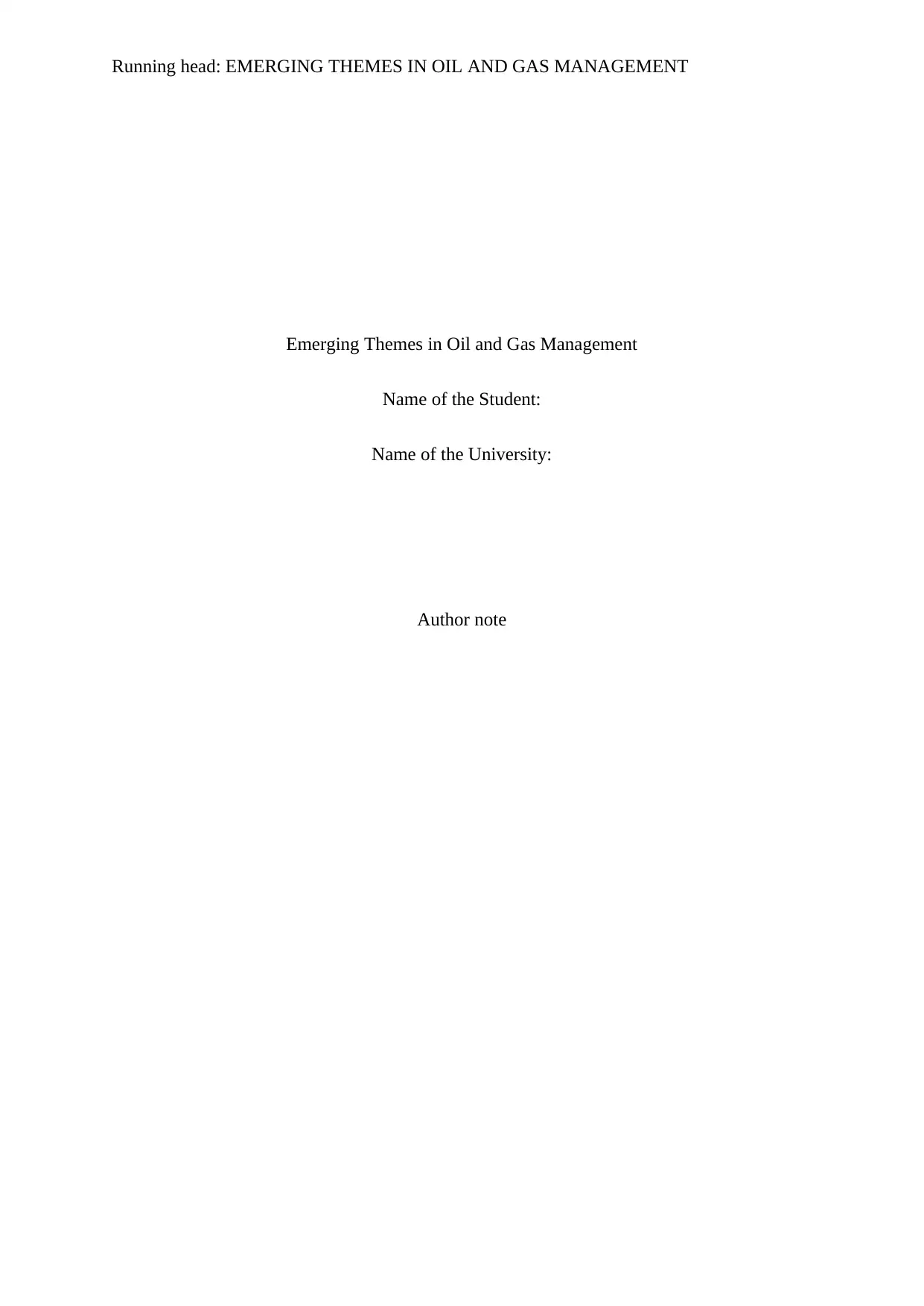
Running head: EMERGING THEMES IN OIL AND GAS MANAGEMENT
Emerging Themes in Oil and Gas Management
Name of the Student:
Name of the University:
Author note
Emerging Themes in Oil and Gas Management
Name of the Student:
Name of the University:
Author note
Paraphrase This Document
Need a fresh take? Get an instant paraphrase of this document with our AI Paraphraser
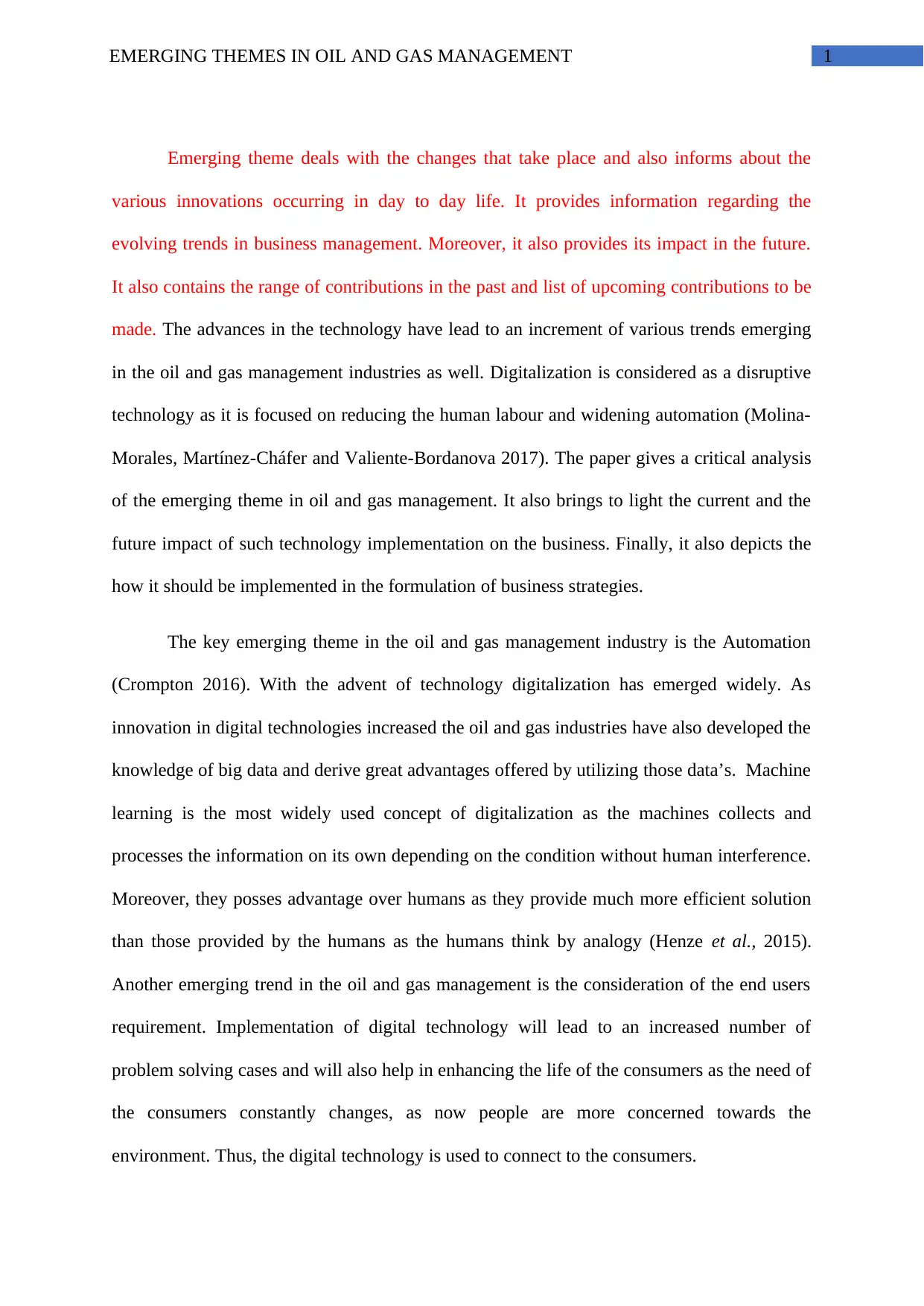
1EMERGING THEMES IN OIL AND GAS MANAGEMENT
Emerging theme deals with the changes that take place and also informs about the
various innovations occurring in day to day life. It provides information regarding the
evolving trends in business management. Moreover, it also provides its impact in the future.
It also contains the range of contributions in the past and list of upcoming contributions to be
made. The advances in the technology have lead to an increment of various trends emerging
in the oil and gas management industries as well. Digitalization is considered as a disruptive
technology as it is focused on reducing the human labour and widening automation (Molina-
Morales, Martínez-Cháfer and Valiente-Bordanova 2017). The paper gives a critical analysis
of the emerging theme in oil and gas management. It also brings to light the current and the
future impact of such technology implementation on the business. Finally, it also depicts the
how it should be implemented in the formulation of business strategies.
The key emerging theme in the oil and gas management industry is the Automation
(Crompton 2016). With the advent of technology digitalization has emerged widely. As
innovation in digital technologies increased the oil and gas industries have also developed the
knowledge of big data and derive great advantages offered by utilizing those data’s. Machine
learning is the most widely used concept of digitalization as the machines collects and
processes the information on its own depending on the condition without human interference.
Moreover, they posses advantage over humans as they provide much more efficient solution
than those provided by the humans as the humans think by analogy (Henze et al., 2015).
Another emerging trend in the oil and gas management is the consideration of the end users
requirement. Implementation of digital technology will lead to an increased number of
problem solving cases and will also help in enhancing the life of the consumers as the need of
the consumers constantly changes, as now people are more concerned towards the
environment. Thus, the digital technology is used to connect to the consumers.
Emerging theme deals with the changes that take place and also informs about the
various innovations occurring in day to day life. It provides information regarding the
evolving trends in business management. Moreover, it also provides its impact in the future.
It also contains the range of contributions in the past and list of upcoming contributions to be
made. The advances in the technology have lead to an increment of various trends emerging
in the oil and gas management industries as well. Digitalization is considered as a disruptive
technology as it is focused on reducing the human labour and widening automation (Molina-
Morales, Martínez-Cháfer and Valiente-Bordanova 2017). The paper gives a critical analysis
of the emerging theme in oil and gas management. It also brings to light the current and the
future impact of such technology implementation on the business. Finally, it also depicts the
how it should be implemented in the formulation of business strategies.
The key emerging theme in the oil and gas management industry is the Automation
(Crompton 2016). With the advent of technology digitalization has emerged widely. As
innovation in digital technologies increased the oil and gas industries have also developed the
knowledge of big data and derive great advantages offered by utilizing those data’s. Machine
learning is the most widely used concept of digitalization as the machines collects and
processes the information on its own depending on the condition without human interference.
Moreover, they posses advantage over humans as they provide much more efficient solution
than those provided by the humans as the humans think by analogy (Henze et al., 2015).
Another emerging trend in the oil and gas management is the consideration of the end users
requirement. Implementation of digital technology will lead to an increased number of
problem solving cases and will also help in enhancing the life of the consumers as the need of
the consumers constantly changes, as now people are more concerned towards the
environment. Thus, the digital technology is used to connect to the consumers.
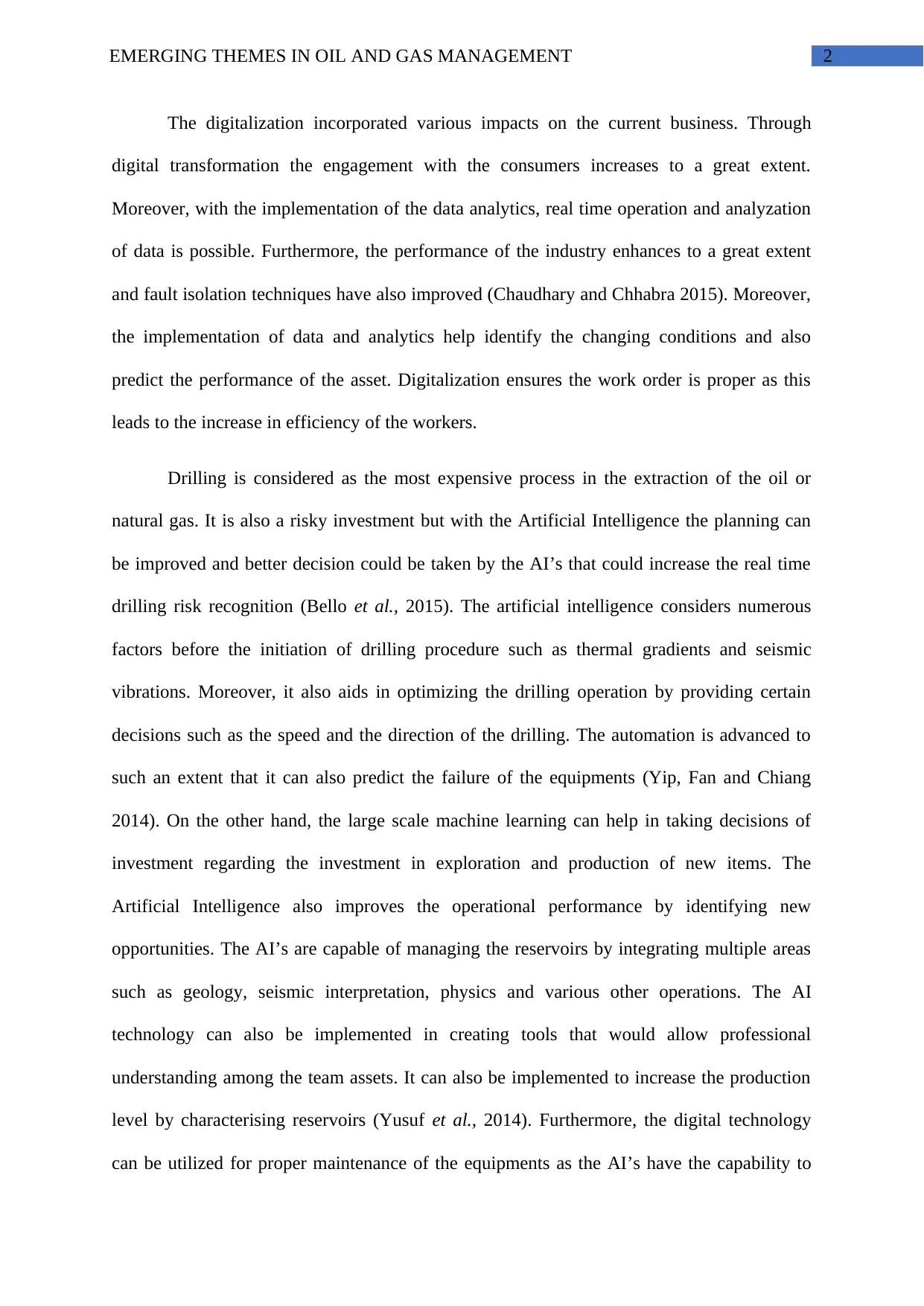
2EMERGING THEMES IN OIL AND GAS MANAGEMENT
The digitalization incorporated various impacts on the current business. Through
digital transformation the engagement with the consumers increases to a great extent.
Moreover, with the implementation of the data analytics, real time operation and analyzation
of data is possible. Furthermore, the performance of the industry enhances to a great extent
and fault isolation techniques have also improved (Chaudhary and Chhabra 2015). Moreover,
the implementation of data and analytics help identify the changing conditions and also
predict the performance of the asset. Digitalization ensures the work order is proper as this
leads to the increase in efficiency of the workers.
Drilling is considered as the most expensive process in the extraction of the oil or
natural gas. It is also a risky investment but with the Artificial Intelligence the planning can
be improved and better decision could be taken by the AI’s that could increase the real time
drilling risk recognition (Bello et al., 2015). The artificial intelligence considers numerous
factors before the initiation of drilling procedure such as thermal gradients and seismic
vibrations. Moreover, it also aids in optimizing the drilling operation by providing certain
decisions such as the speed and the direction of the drilling. The automation is advanced to
such an extent that it can also predict the failure of the equipments (Yip, Fan and Chiang
2014). On the other hand, the large scale machine learning can help in taking decisions of
investment regarding the investment in exploration and production of new items. The
Artificial Intelligence also improves the operational performance by identifying new
opportunities. The AI’s are capable of managing the reservoirs by integrating multiple areas
such as geology, seismic interpretation, physics and various other operations. The AI
technology can also be implemented in creating tools that would allow professional
understanding among the team assets. It can also be implemented to increase the production
level by characterising reservoirs (Yusuf et al., 2014). Furthermore, the digital technology
can be utilized for proper maintenance of the equipments as the AI’s have the capability to
The digitalization incorporated various impacts on the current business. Through
digital transformation the engagement with the consumers increases to a great extent.
Moreover, with the implementation of the data analytics, real time operation and analyzation
of data is possible. Furthermore, the performance of the industry enhances to a great extent
and fault isolation techniques have also improved (Chaudhary and Chhabra 2015). Moreover,
the implementation of data and analytics help identify the changing conditions and also
predict the performance of the asset. Digitalization ensures the work order is proper as this
leads to the increase in efficiency of the workers.
Drilling is considered as the most expensive process in the extraction of the oil or
natural gas. It is also a risky investment but with the Artificial Intelligence the planning can
be improved and better decision could be taken by the AI’s that could increase the real time
drilling risk recognition (Bello et al., 2015). The artificial intelligence considers numerous
factors before the initiation of drilling procedure such as thermal gradients and seismic
vibrations. Moreover, it also aids in optimizing the drilling operation by providing certain
decisions such as the speed and the direction of the drilling. The automation is advanced to
such an extent that it can also predict the failure of the equipments (Yip, Fan and Chiang
2014). On the other hand, the large scale machine learning can help in taking decisions of
investment regarding the investment in exploration and production of new items. The
Artificial Intelligence also improves the operational performance by identifying new
opportunities. The AI’s are capable of managing the reservoirs by integrating multiple areas
such as geology, seismic interpretation, physics and various other operations. The AI
technology can also be implemented in creating tools that would allow professional
understanding among the team assets. It can also be implemented to increase the production
level by characterising reservoirs (Yusuf et al., 2014). Furthermore, the digital technology
can be utilized for proper maintenance of the equipments as the AI’s have the capability to
⊘ This is a preview!⊘
Do you want full access?
Subscribe today to unlock all pages.

Trusted by 1+ million students worldwide
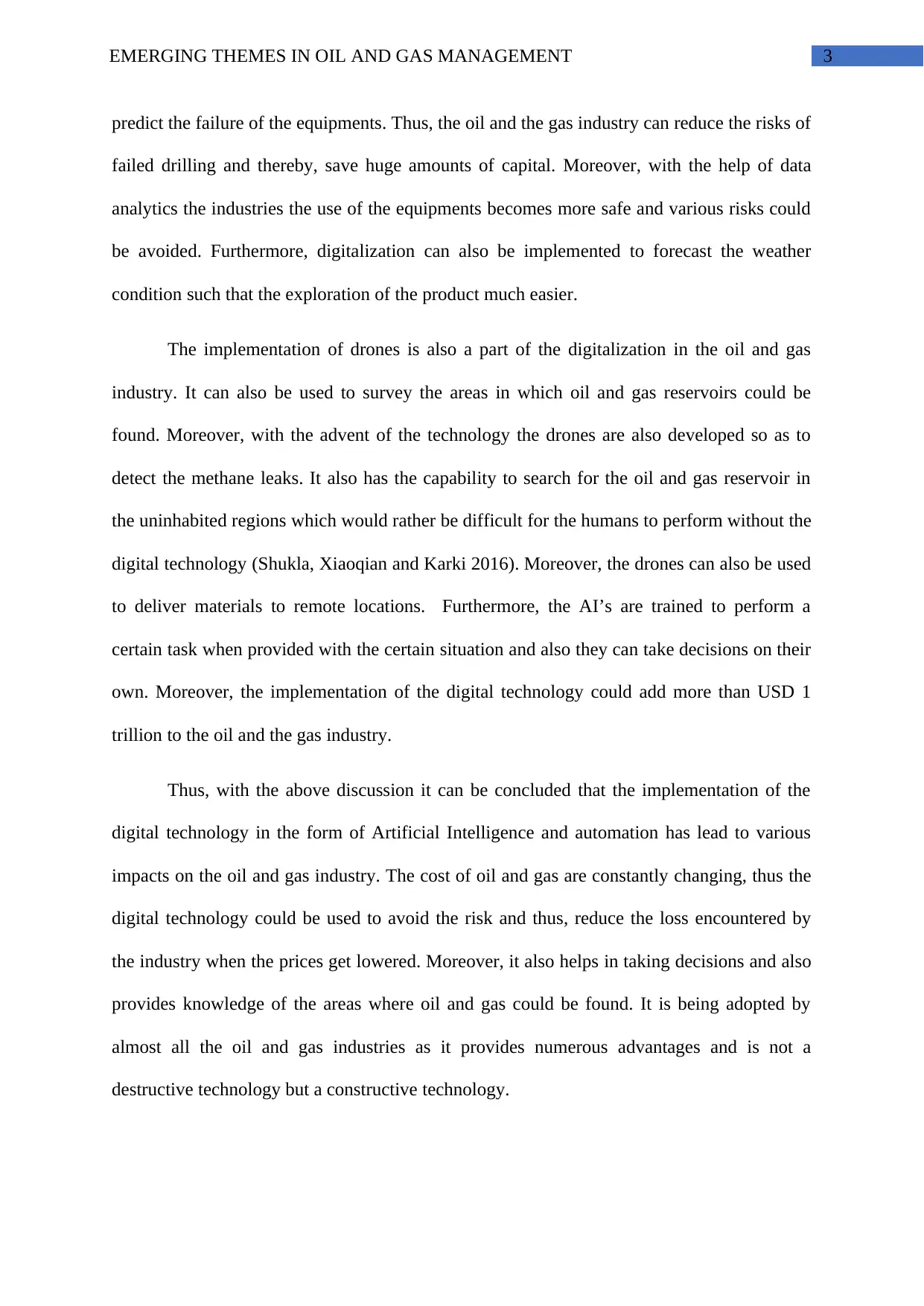
3EMERGING THEMES IN OIL AND GAS MANAGEMENT
predict the failure of the equipments. Thus, the oil and the gas industry can reduce the risks of
failed drilling and thereby, save huge amounts of capital. Moreover, with the help of data
analytics the industries the use of the equipments becomes more safe and various risks could
be avoided. Furthermore, digitalization can also be implemented to forecast the weather
condition such that the exploration of the product much easier.
The implementation of drones is also a part of the digitalization in the oil and gas
industry. It can also be used to survey the areas in which oil and gas reservoirs could be
found. Moreover, with the advent of the technology the drones are also developed so as to
detect the methane leaks. It also has the capability to search for the oil and gas reservoir in
the uninhabited regions which would rather be difficult for the humans to perform without the
digital technology (Shukla, Xiaoqian and Karki 2016). Moreover, the drones can also be used
to deliver materials to remote locations. Furthermore, the AI’s are trained to perform a
certain task when provided with the certain situation and also they can take decisions on their
own. Moreover, the implementation of the digital technology could add more than USD 1
trillion to the oil and the gas industry.
Thus, with the above discussion it can be concluded that the implementation of the
digital technology in the form of Artificial Intelligence and automation has lead to various
impacts on the oil and gas industry. The cost of oil and gas are constantly changing, thus the
digital technology could be used to avoid the risk and thus, reduce the loss encountered by
the industry when the prices get lowered. Moreover, it also helps in taking decisions and also
provides knowledge of the areas where oil and gas could be found. It is being adopted by
almost all the oil and gas industries as it provides numerous advantages and is not a
destructive technology but a constructive technology.
predict the failure of the equipments. Thus, the oil and the gas industry can reduce the risks of
failed drilling and thereby, save huge amounts of capital. Moreover, with the help of data
analytics the industries the use of the equipments becomes more safe and various risks could
be avoided. Furthermore, digitalization can also be implemented to forecast the weather
condition such that the exploration of the product much easier.
The implementation of drones is also a part of the digitalization in the oil and gas
industry. It can also be used to survey the areas in which oil and gas reservoirs could be
found. Moreover, with the advent of the technology the drones are also developed so as to
detect the methane leaks. It also has the capability to search for the oil and gas reservoir in
the uninhabited regions which would rather be difficult for the humans to perform without the
digital technology (Shukla, Xiaoqian and Karki 2016). Moreover, the drones can also be used
to deliver materials to remote locations. Furthermore, the AI’s are trained to perform a
certain task when provided with the certain situation and also they can take decisions on their
own. Moreover, the implementation of the digital technology could add more than USD 1
trillion to the oil and the gas industry.
Thus, with the above discussion it can be concluded that the implementation of the
digital technology in the form of Artificial Intelligence and automation has lead to various
impacts on the oil and gas industry. The cost of oil and gas are constantly changing, thus the
digital technology could be used to avoid the risk and thus, reduce the loss encountered by
the industry when the prices get lowered. Moreover, it also helps in taking decisions and also
provides knowledge of the areas where oil and gas could be found. It is being adopted by
almost all the oil and gas industries as it provides numerous advantages and is not a
destructive technology but a constructive technology.
Paraphrase This Document
Need a fresh take? Get an instant paraphrase of this document with our AI Paraphraser
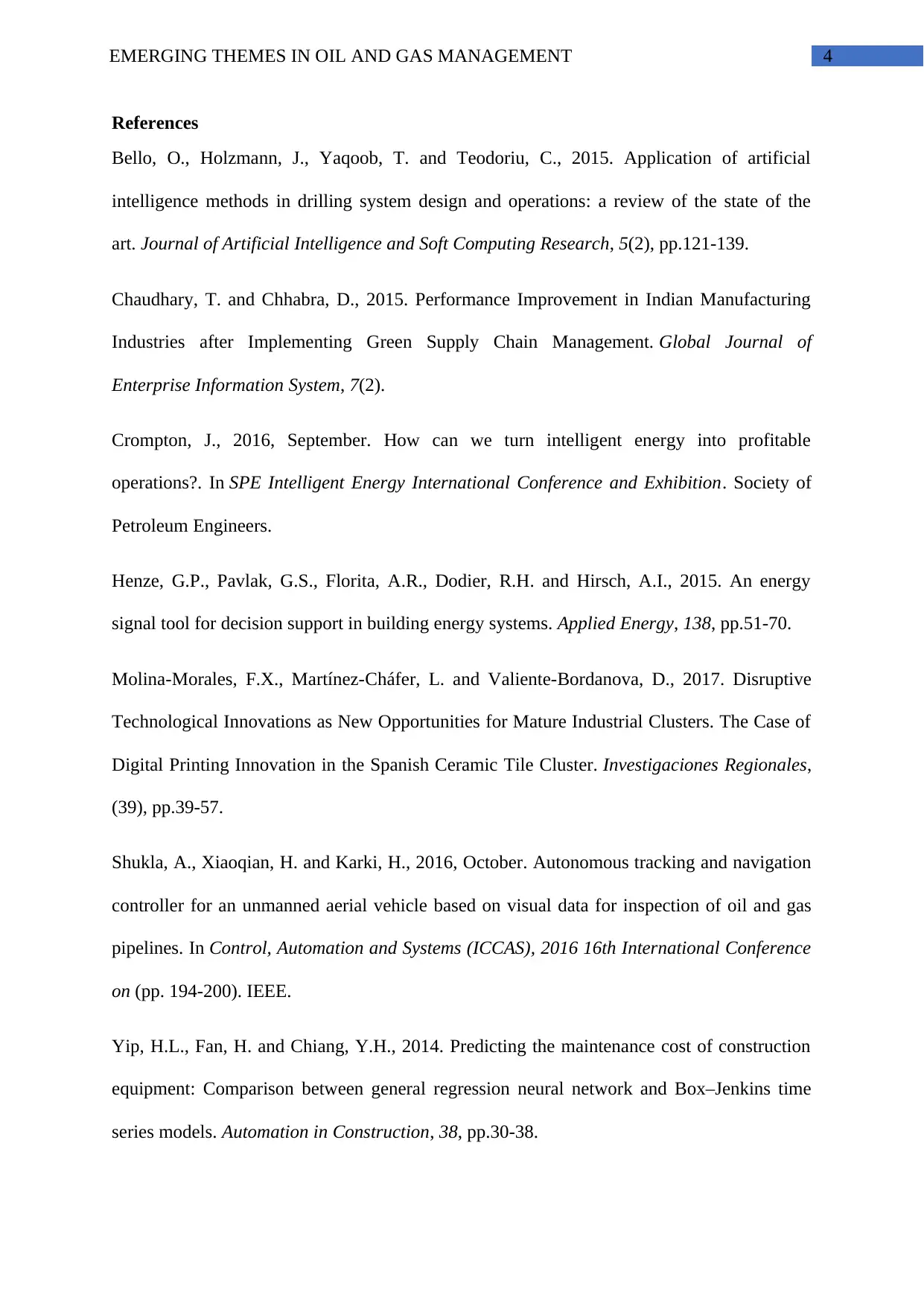
4EMERGING THEMES IN OIL AND GAS MANAGEMENT
References
Bello, O., Holzmann, J., Yaqoob, T. and Teodoriu, C., 2015. Application of artificial
intelligence methods in drilling system design and operations: a review of the state of the
art. Journal of Artificial Intelligence and Soft Computing Research, 5(2), pp.121-139.
Chaudhary, T. and Chhabra, D., 2015. Performance Improvement in Indian Manufacturing
Industries after Implementing Green Supply Chain Management. Global Journal of
Enterprise Information System, 7(2).
Crompton, J., 2016, September. How can we turn intelligent energy into profitable
operations?. In SPE Intelligent Energy International Conference and Exhibition. Society of
Petroleum Engineers.
Henze, G.P., Pavlak, G.S., Florita, A.R., Dodier, R.H. and Hirsch, A.I., 2015. An energy
signal tool for decision support in building energy systems. Applied Energy, 138, pp.51-70.
Molina-Morales, F.X., Martínez-Cháfer, L. and Valiente-Bordanova, D., 2017. Disruptive
Technological Innovations as New Opportunities for Mature Industrial Clusters. The Case of
Digital Printing Innovation in the Spanish Ceramic Tile Cluster. Investigaciones Regionales,
(39), pp.39-57.
Shukla, A., Xiaoqian, H. and Karki, H., 2016, October. Autonomous tracking and navigation
controller for an unmanned aerial vehicle based on visual data for inspection of oil and gas
pipelines. In Control, Automation and Systems (ICCAS), 2016 16th International Conference
on (pp. 194-200). IEEE.
Yip, H.L., Fan, H. and Chiang, Y.H., 2014. Predicting the maintenance cost of construction
equipment: Comparison between general regression neural network and Box–Jenkins time
series models. Automation in Construction, 38, pp.30-38.
References
Bello, O., Holzmann, J., Yaqoob, T. and Teodoriu, C., 2015. Application of artificial
intelligence methods in drilling system design and operations: a review of the state of the
art. Journal of Artificial Intelligence and Soft Computing Research, 5(2), pp.121-139.
Chaudhary, T. and Chhabra, D., 2015. Performance Improvement in Indian Manufacturing
Industries after Implementing Green Supply Chain Management. Global Journal of
Enterprise Information System, 7(2).
Crompton, J., 2016, September. How can we turn intelligent energy into profitable
operations?. In SPE Intelligent Energy International Conference and Exhibition. Society of
Petroleum Engineers.
Henze, G.P., Pavlak, G.S., Florita, A.R., Dodier, R.H. and Hirsch, A.I., 2015. An energy
signal tool for decision support in building energy systems. Applied Energy, 138, pp.51-70.
Molina-Morales, F.X., Martínez-Cháfer, L. and Valiente-Bordanova, D., 2017. Disruptive
Technological Innovations as New Opportunities for Mature Industrial Clusters. The Case of
Digital Printing Innovation in the Spanish Ceramic Tile Cluster. Investigaciones Regionales,
(39), pp.39-57.
Shukla, A., Xiaoqian, H. and Karki, H., 2016, October. Autonomous tracking and navigation
controller for an unmanned aerial vehicle based on visual data for inspection of oil and gas
pipelines. In Control, Automation and Systems (ICCAS), 2016 16th International Conference
on (pp. 194-200). IEEE.
Yip, H.L., Fan, H. and Chiang, Y.H., 2014. Predicting the maintenance cost of construction
equipment: Comparison between general regression neural network and Box–Jenkins time
series models. Automation in Construction, 38, pp.30-38.

5EMERGING THEMES IN OIL AND GAS MANAGEMENT
Yusuf, Y.Y., Gunasekaran, A., Musa, A., Dauda, M., El-Berishy, N.M. and Cang, S., 2014. A
relational study of supply chain agility, competitiveness and business performance in the oil
and gas industry. International Journal of Production Economics, 147, pp.531-543.
Yusuf, Y.Y., Gunasekaran, A., Musa, A., Dauda, M., El-Berishy, N.M. and Cang, S., 2014. A
relational study of supply chain agility, competitiveness and business performance in the oil
and gas industry. International Journal of Production Economics, 147, pp.531-543.
⊘ This is a preview!⊘
Do you want full access?
Subscribe today to unlock all pages.

Trusted by 1+ million students worldwide
1 out of 6
Related Documents
Your All-in-One AI-Powered Toolkit for Academic Success.
+13062052269
info@desklib.com
Available 24*7 on WhatsApp / Email
![[object Object]](/_next/static/media/star-bottom.7253800d.svg)
Unlock your academic potential
Copyright © 2020–2025 A2Z Services. All Rights Reserved. Developed and managed by ZUCOL.





